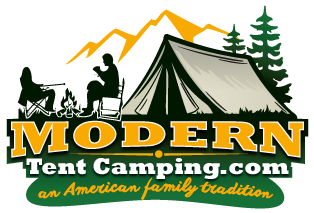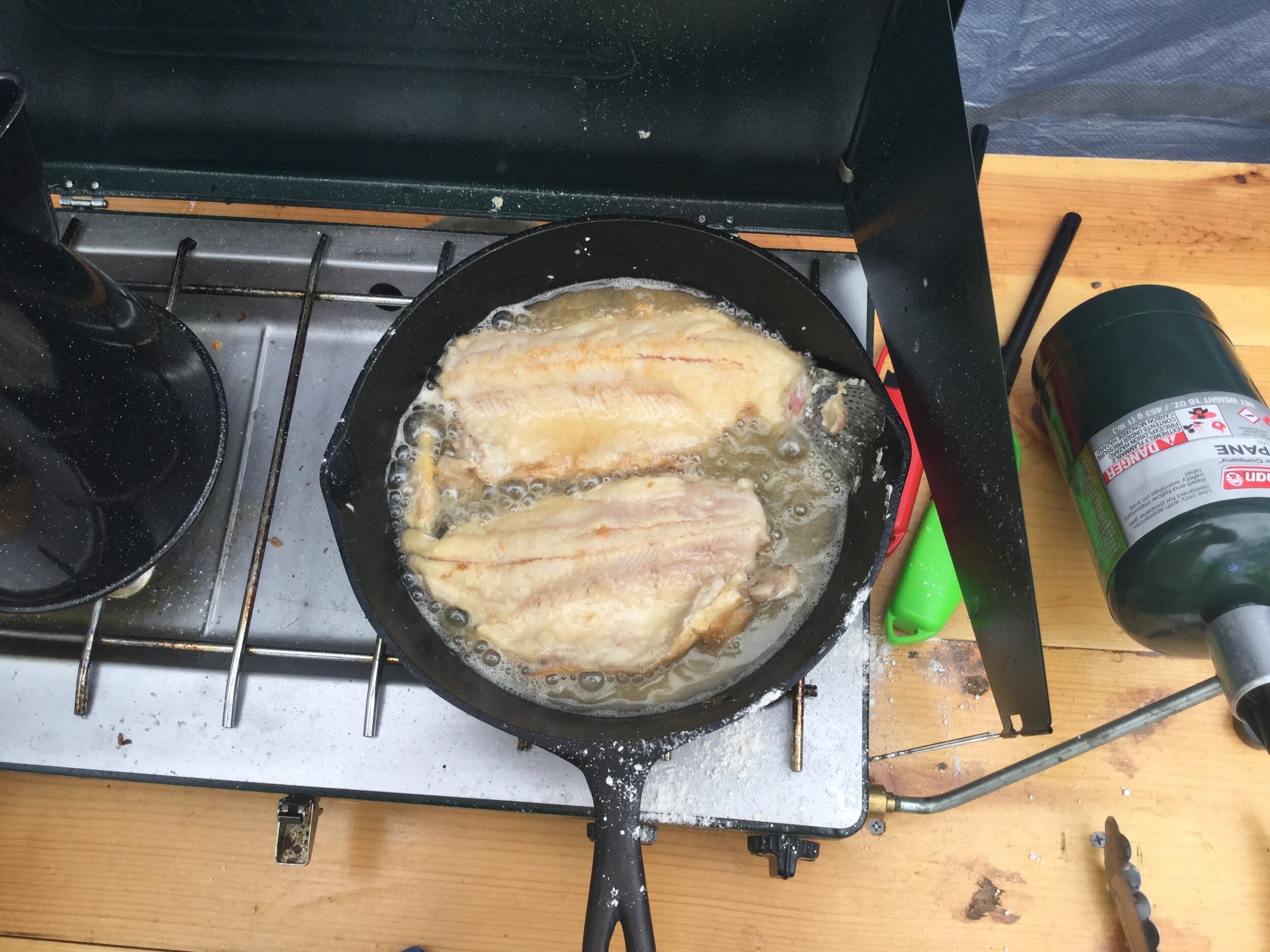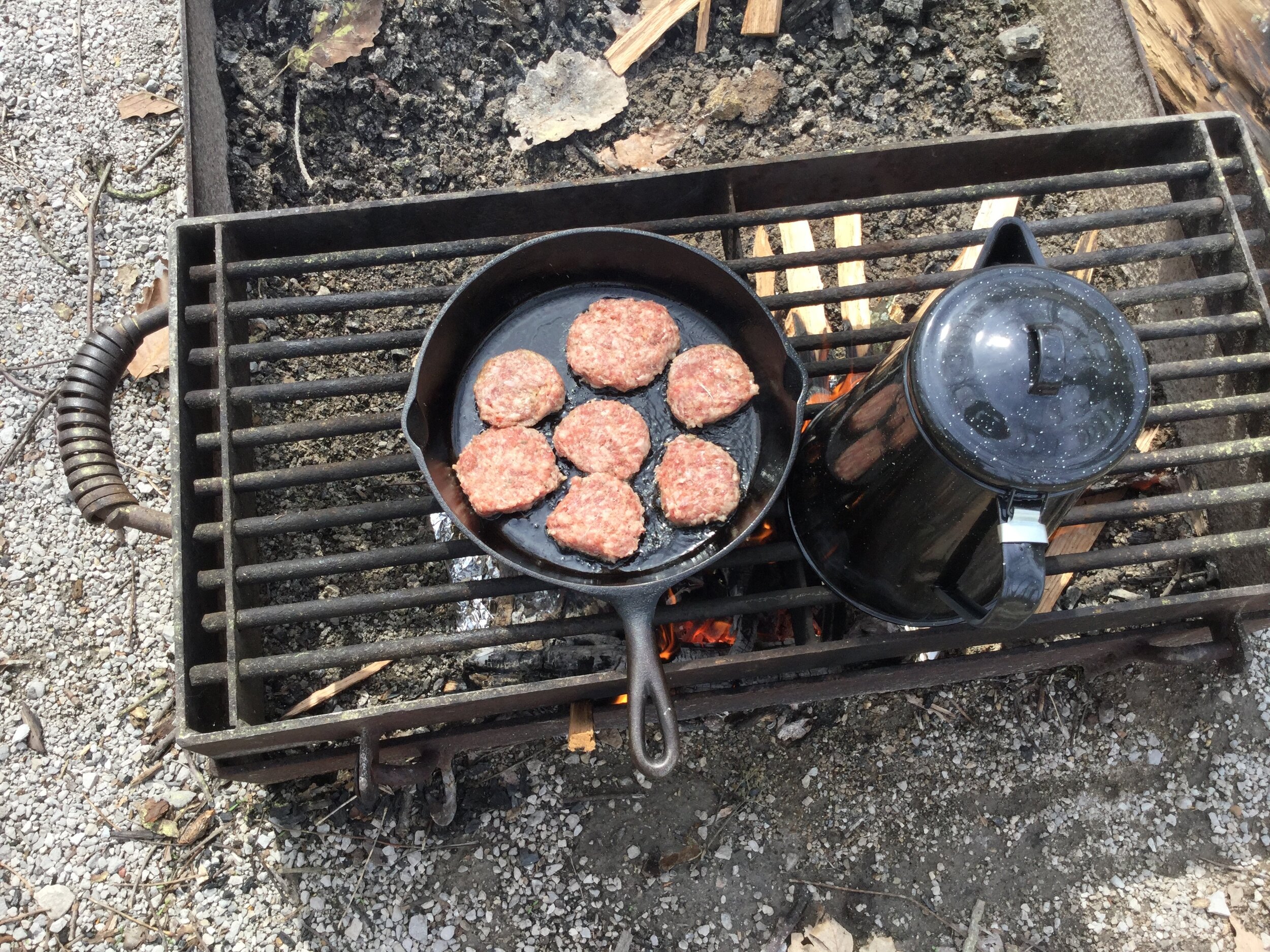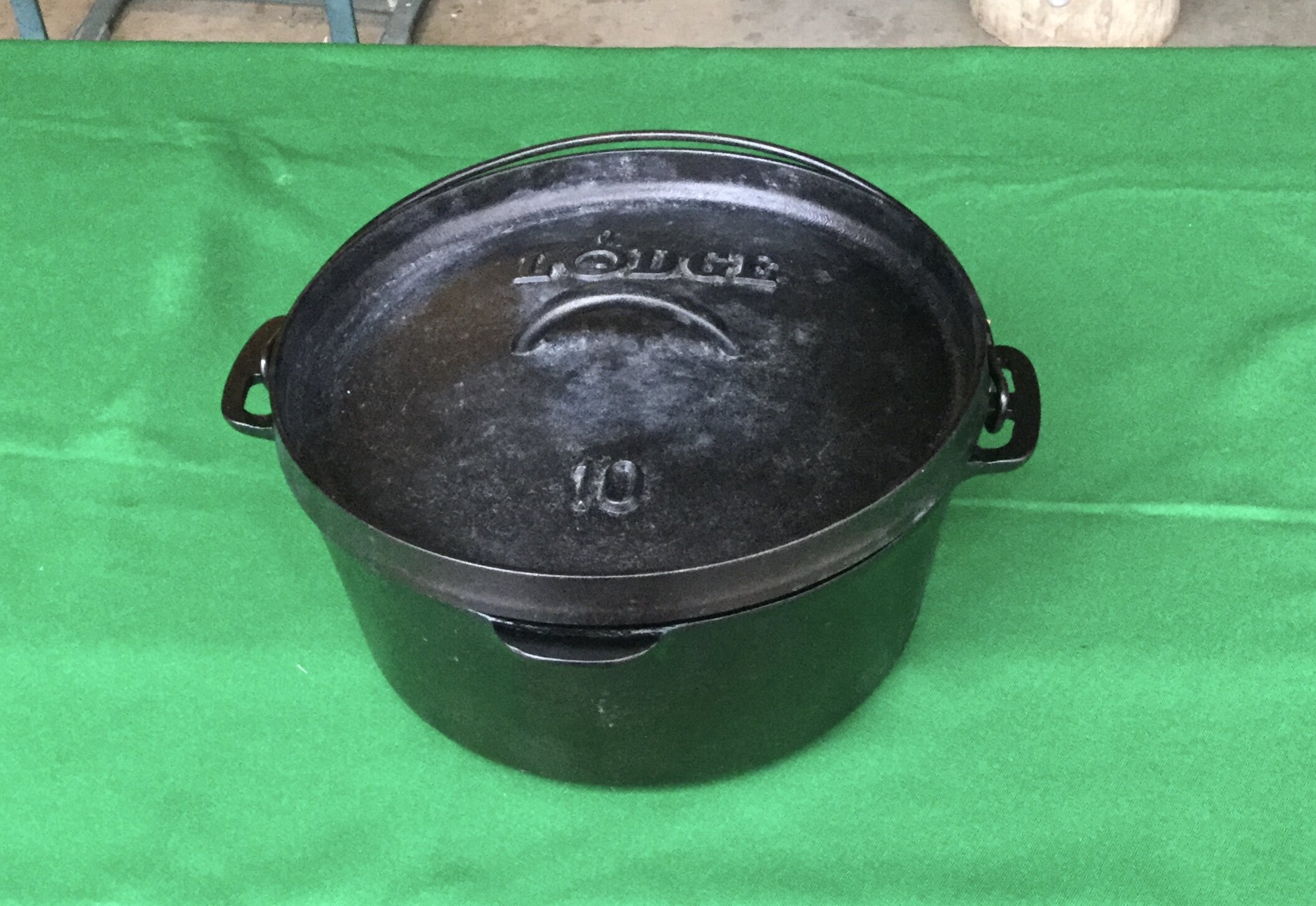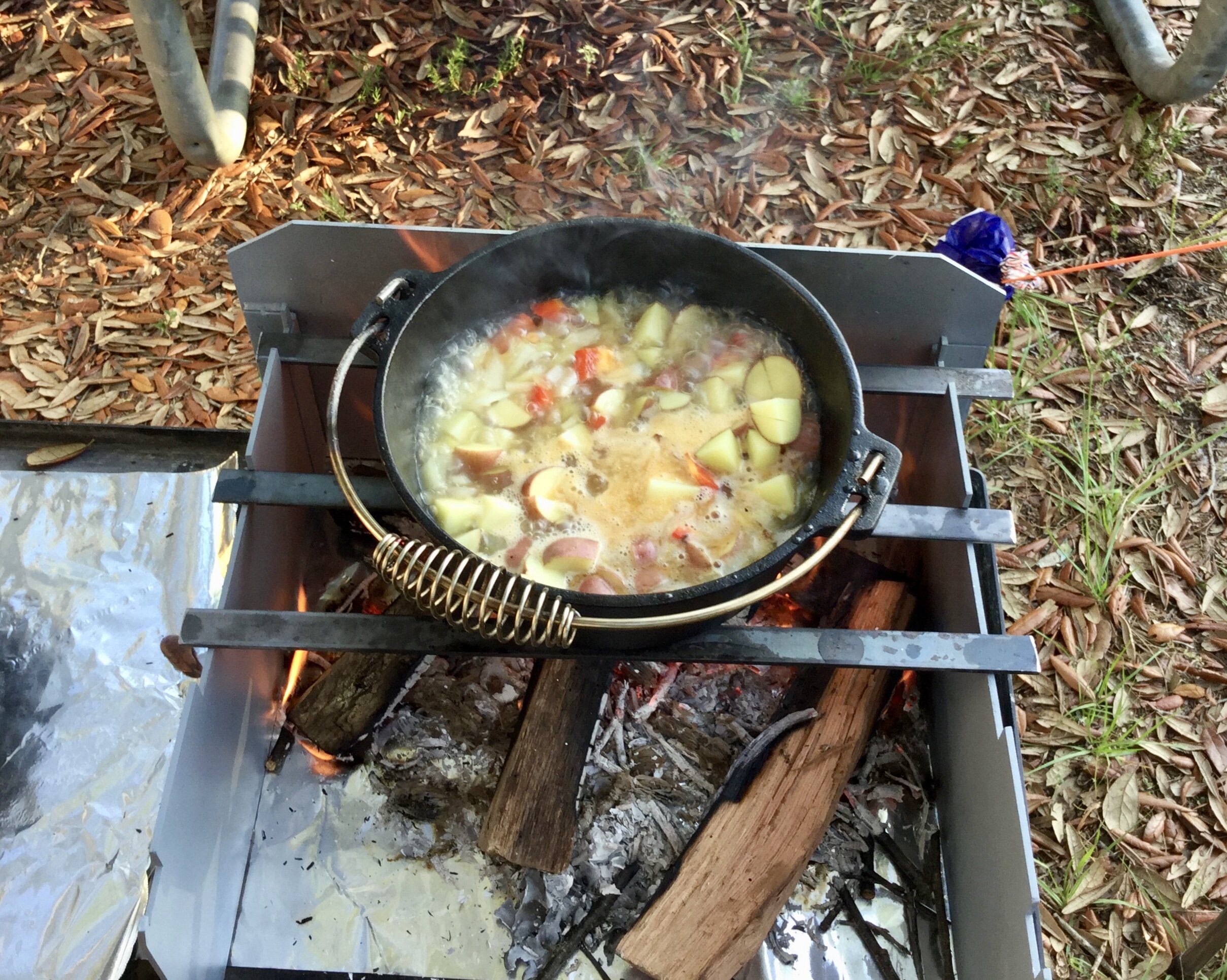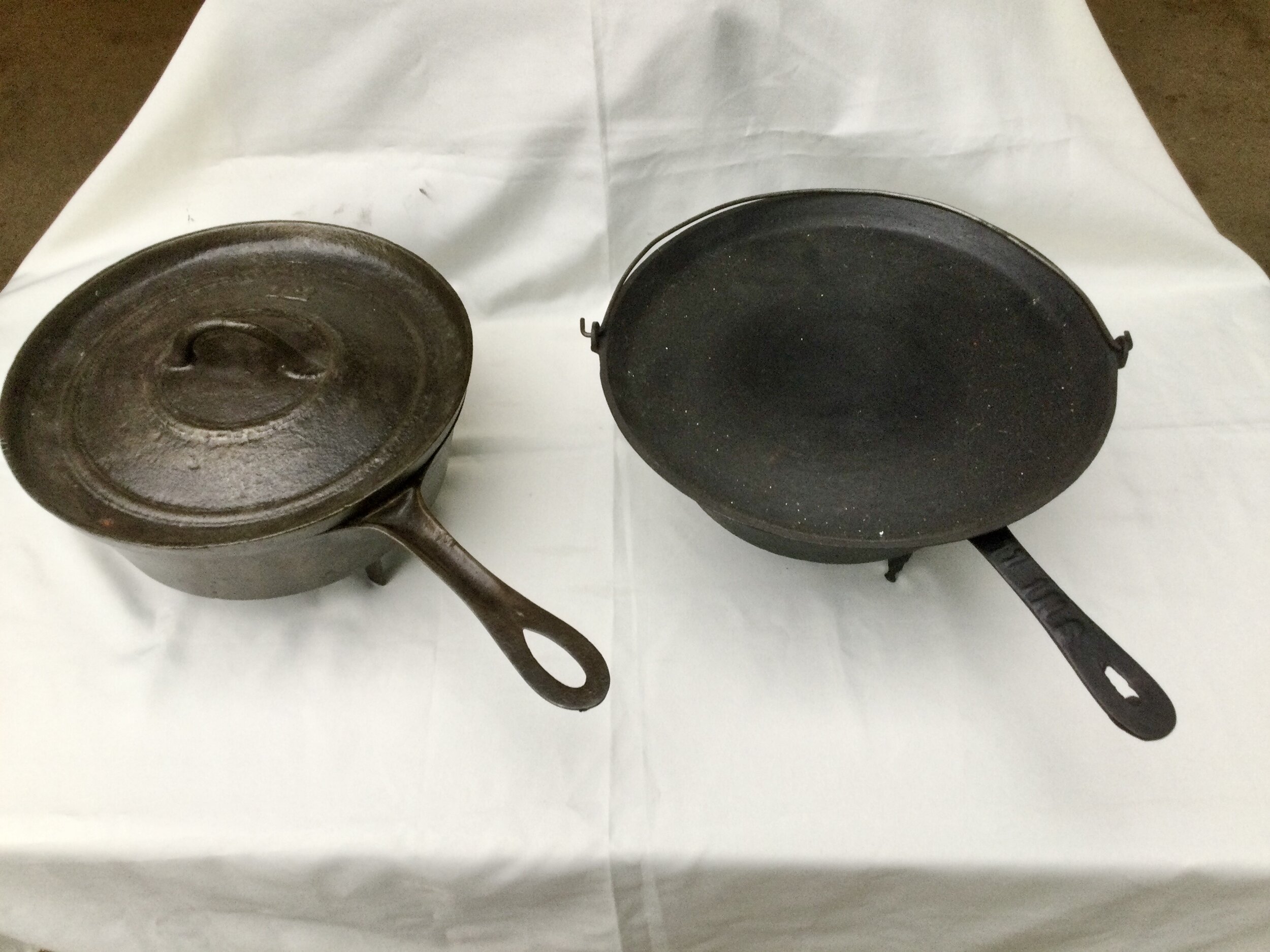Add a Cast Iron Skillet and Dutch Oven
If you want to cook a wide range of delicious meals on your camping trips, you should buy a cast iron skillet and Dutch Oven for your camp kitchen - and discard your aluminum pots and pans. Cast iron allows you to fry a variety of foods to perfection, simmer stews and soups for extended lengths of time (without scorching), and occasionally bake casseroles, breads, deserts, and other foods. Here are a few facts and tips that may help you find the best cast iron pieces for your family camping kitchen.
Best Cast Iron Cookware for Family Camping
SKILLET
Camping families should have a cast iron skillet to sauté and fry foods needed for almost every meal - and the skillet should measure about 10-inches in diameter. This size is large enough to cook foods for 6 to 8 people but small enough to fit onto camp stove eyes and pack in small spaces. Furthermore, this size is easy to find, reasonably priced, easy to handle, and easy to fit with a lid. Although chuck wagon cooks usually recommend larger 12 to 14-inch diameter skillets, these larger skillets are made to feed 10 to 15 young hungry men. Furthermore, larger skillets are heavy, hard to handle, too big to fit on many stove eyes, difficult to find, hard to clean, and very expensive.
Lodge, Camp Chef, and several other companies make reasonably good and economically-priced (less than $30) cast iron skillets but these skillets are relatively heavy (weigh over 5 pounds) and have rough cooking surfaces. I prefer vintage skillets made by Wagner or unmarked, bottom-gated skillets that can be found on eBay and in many antique stores. These vintage skillets are lightweight and have ultra smooth cooking surfaces. Old Lodge and Birmingham Stove and Range (BSR) skillets are a little heavier but also have smooth cooking surfaces and are more economically priced.
DUTCH OVEN
Camping families should also buy a 5-quart cast-iron Dutch oven (about 10 inches in diameter) to simmer soups and stews without scorching and to bake roasts, casseroles, breads, and deserts - over a campfire or on a camp stove or home stove.
The oven should have a flat bottom (with no legs) and a flat top with an outside lip - but this combination is very hard to find! Most definitely, the oven should have a FLAT BOTTOM with no legs because legs are made for campfire cooking ONLY - and most modern tent camping families will want to cook on their camp stoves, pedestal grills, or fire ring grill - and perhaps also in (or on) their home stoves. Furthermore, cast iron camp ovens with no legs are easier to pack and easier to clean. If possible, the oven should also have a FLAT LID with an outside flange or lip to hold hot coals for baking. But, if you can’t find a flat lid, you could do as we have done in the past. Use a cake ring to hold coals on top of a domed lid.
As previously stated, it is very hard to find a flat bottom Dutch oven with a flat lid. Occasionally, you can find them on the web. For example, Bayou Classic and Camp Chef have made them in the past. Another way to get one is to go to the Lodge Factory Outlet store, buy a factory second flat bottom dutch oven, and then buy a factory second flat camp oven lid. Or, you can do as we did - buy an older 5-quart, flat-bottom Wagner Dutch oven in an antique store or flea market and then buy a new 10-inch flat Lodge Lid.
Fresh caught trout frying in an old Wagner cast iron skillet.
Sausage frying in the skillet for breakfast.
We have an older 5-quart Wagner Dutch oven with a flat bottom and a new Lodge flat lid.
A cake ring will hold hot coals on a domed lid.
Cast Iron Cooking Tips
CAUTION! Cast iron can get dangerously HOT! Focus attention on cooking. Do not get into a hurry or attempt to do other tasks away from the cooking area. Always wear leather gloves and use hot handle holders.
Apply a light coat of oil to the pan before cooking.
Always cook at medium to low temperatures. Never cook on high temperature because the heat could warp the pan or pot.
Use wood, bamboo, or Nylon utensils rather than metal to preserve the smooth cooking surfac
After every use, wipe away food and excess oil with a paper towel.
If food is stuck on, boil water in it, and then scrub with a bristle brush. If food is still stuck, gently use a thin plastic or metal paint scraper to remove the food and then scrub with hot water.
Avoid soap as much as possible because it can remove baked on oil and will leave a bad taste in the pan.
After cleaning the piece, dry it completely, apply a thin coat of oil, heat it until it smokes, and then wipe away excess oil.
Never pour cold water into a hot pan. A radical temperature change could crack it.
Be extra careful with heavy cast iron lids (especially domed lids). They can easily fall off of crowded counter tops and crack.
Read Internet Blogs and watch YouTube videos to learn how to cook and care for cast iron. My favorites are Cowboy Kent Rollins, Cast Iron Chaos, Cast Iron Cookware, Backwoods Gourmet, and The Culinary Fanatic.
Finding Vintage Cast Iron
When shopping for a used cast iron piece, check carefully to be sure it has a relatively flat bottom (not warped), no legs, no cracks, and relatively little rust. Sticky pans and ovens are fine because they can be easily cleaned. But avoid heavily rusted pans because restoration requires considerable time, materials, and knowledge.
Look for a #7 or #8 (10-inch) vintage skillet and a 5-quart, flat-bottom Dutch oven. You should be able to find a good oven for less than $50 but a good flat lid will add another $50 or so to the price. If it does not have a flat lid, you can buy a flat lid to fit your oven or use a cake ring to hold coals on a domed lid.
We prefer early Wagner (1881 – 1960 ) skillets and Dutch ovens because they are well made, lightweight and have very smooth cooking surfaces. And they are reasonably priced. Unmarked Wagners are even more reasonably priced. Griswold (1865 - 1957) is another great vintage brand but most pieces are much more expensive than Wagner’s. Early Lodge (1896 – 1960), Birmingham Stove & Range aka BSR (1902 – 1989), Martin Stove & Range (1919 - 1955) & Vollrath (1874 – 1945) are also good brands. Skillets marked “Made in U.S.A.”, made after 1960, usually cost less than $25. They would make great camp skillets but they typically are heavier and rougher than older skillets.
The fastest way to find a good vintage skillet or Dutch oven is to look on eBay but you will have to pay a few dollars more for the piece plus shipping fees. Cheaper pieces can be found in antique stores but you may have to spend a lot of time, money, and effort making multiple trips until you find a good piece. On rare occasions, you can find a good piece in an estate sale or yard sale but you will have to spend a lot of time, effort, and money visiting many before you stumble onto a good piece. They are hard to find in estate sales because professional antique dealers get to see all the good stuff before you have a chance to see it.
Once you find your cookware, start cooking pioneer dishes at home and in your campsite. For example, hoe cakes are well known, easy to make, and very tasty.
Cleaning Old Cast Iron
If you buy a used piece of cast iron, clean it throughly before cooking in it. First, scrub well with soap and water.
Remove sticky, baked-on food by baking the piece in home oven at 450 degrees for 2 hours and then allowing it to cool in the oven for another hour. Warning, this will usually make your house smell bad for a while. A few people have recommended throwing the piece in a fire but most knowledgeable authorities assert that this method could possibly damage the iron.
Remove rust by one of three methods. I use a white vinegar bath with no problems - but other writers claim that this method could damage cast iron. Other collectors and dealers recommend E-Z Off Oven Cleaner and electrolysis but these methods require considerable equipment, time, and space. Other collectors have recommended using coarse salt with a little water, sandpaper, wire brushes, and a wire wheel.
After removing baked on food and rust, rinse well and dry in the oven on low heat.
When you get a dirty piece of cast iron, wash with a mild soap solution, rinse, soak in vinegar for a day to loosen rust, brush with a stiff brush, bake in your home oven for 2 hours at 450 degrees, cool, and then oil with Crisco or oil.
Boiled potato and sausage stew in a Bayou Classic Dutch oven.
Old spiders had 3 legs designed for campfire and hearth cooking.
Many spiders also had flat lids to hold hot coals for baking.
Oiling (Seasoning) a Clean Pan
Before cooking in a cast iron pan or oven the first time, you should bake some oil on its sides and bottom. This process has been called “Seasoning” but I prefer to use the term “Oiling.” I prefer the term “Oiling” because it refers to something you do to enhance rust resistance and non-stick properties - while the term “Seasoning” refers to an invisible chemical process (fat polymerization) which cannot be seen or measured. This Oiling will protect the pan from rust and give it an almost non-stick cooking surface.
We use Crisco to oil our cast iron but other enthusiasts have recommended Flax seed oil, grape seed oil, EZ Beesey, and other products. A few authorities say that all you really have to do is fry some bacon or grated potatoes in bacon grease.
Typically, new buyers are advised to apply a thin coat of oil and bake it 30 minutes at 400 degrees until it begins to smoke. Then let it cool, apply a second coat of oil, and bake it a second time. Two applications seem sufficient to me but some enthusiasts recommend 3 or more applications.
History of Cast Iron Cookware
Cast iron cookware was first developed in China about 1,500 years ago - but it was difficult to make and very heavy. Thus, it was rarely used.
In 1708, Abraham Darby of England developed a new method for casting iron cookware that made it much easier to make and much lighter. Thus began widespread use of cast iron cookware.
During the 1700s and most of the 1800s, cast iron cookware was designed for campfire cooking. Most cookware had 3 legs that allowed the cook to shovel hot coals under the piece for frying and baking. Pots had wire bail handles that could be hung from a lug pole above the fire. Lids or covers, frequently made from wood or tin, were used to keep ashes out of the food.
The “Spider” was a versatile piece of cookware that could cook almost any food. It was a deep, 12 to 14 inch wide skillet with 3 legs, a long handle, smooth cooking surface, and a flanged cast iron lid or cover that reportedly was developed by Paul Revere. It could be set on top of a bed of hot coals and used to pan fry bacon and hoe cakes, deep fry fish and chicken, boil beans and other vegetables, simmer soups and stews, and bake breads and deserts. But, despite their versatility, these spiders were heavy and awkward to use. And gradually were replaced by lighter skillets and Dutch ovens.
During the 1700s and most of the 1800s, cast iron cookware was made in small foundries that emerged in most large eastern cities. When older pieces of cookware were cast, makers poured the molten iron into the mold through a bottom spru or gate. And when the iron hardened, a visible spru or gate mark was left on the bottom of the piece. Today, we call these older pieces “bottom gate-marked.” Typically, these foundries made their cookware for local families and almost never marked the cookware with their name or mark. This lack of markings makes it almost impossible today to determine where or when many old cast iron pieces were made.
In 1740, wood cook stoves were developed and slowly spread across the American frontier until the early 1900s. As they became more widely used, foundries began removing legs from cast iron pots and pans and replaced these legs with heat or smoke rings to fit snuggly inside stovetop openings.
In 1802, gas cook stoves were developed but did not affect the design of cast iron cook ware. Pots and pans designed for wood stoves worked just as well on gas stoves.
In 1896, electric cook stoves were developed but could only be used in large eastern cities until the 1930s when rural electrification began to occur. As they became more popular, legs and heat rings were removed from the bottom of cast iron pans but some foundries continued to sell cookware with heat rings until the 1940s.
Although most early cast iron factories did not mark their cookware, the Erie - Griswold company, founded in Erie Pennsylvania in 1865, was a notable exception. From the beginning, Griswold used an improved side-gating method for casting their cookware and marked most pieces - first with the name of their town “Erie” and later with the name of their company “Griswold.” Consequently, early Griswold cast iron pieces are now highly prized by collectors. Subsequently, several other companies - including Wagner, Vollrath, Martin, and Lodge began marking their cookware.
